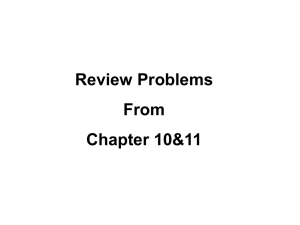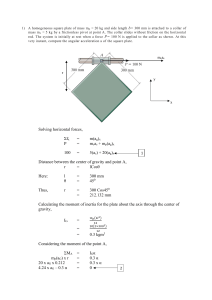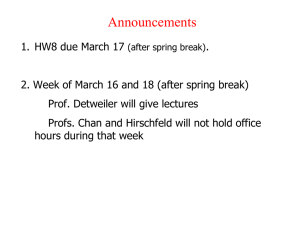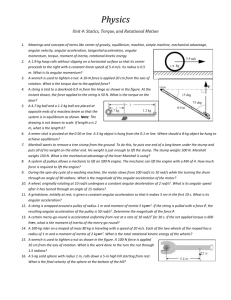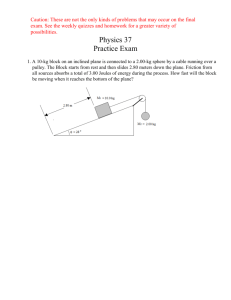10 ver 1.0 KFUPM - Physics Department
advertisement
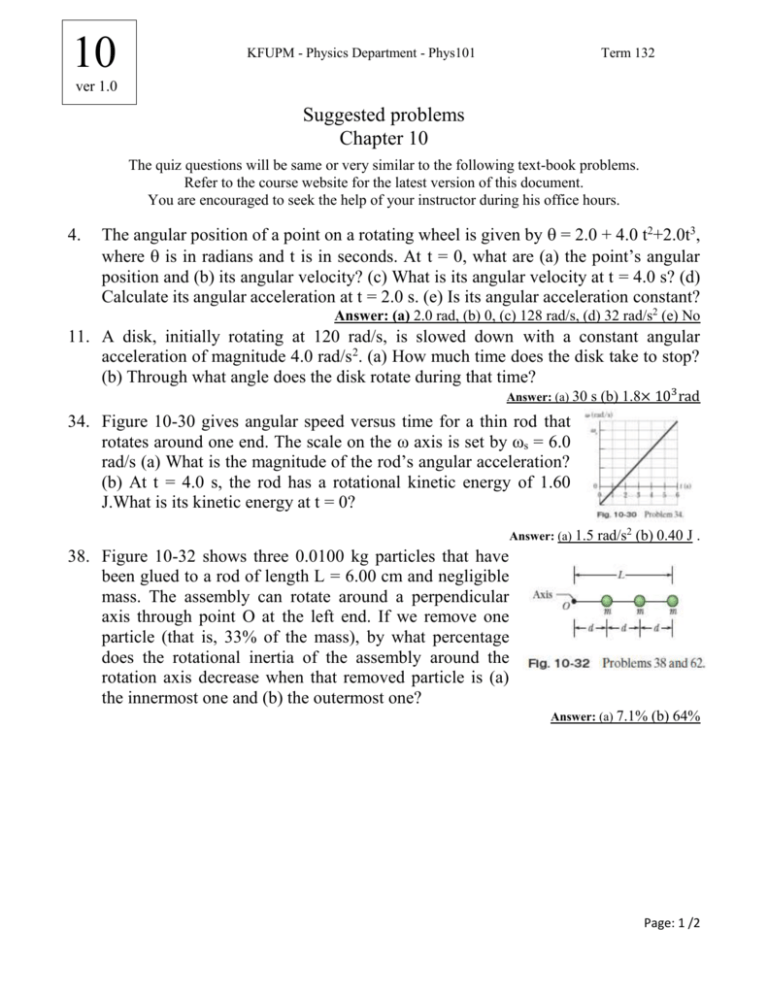
10 KFUPM - Physics Department - Phys101 Term 132 ver 1.0 Suggested problems Chapter 10 The quiz questions will be same or very similar to the following text-book problems. Refer to the course website for the latest version of this document. You are encouraged to seek the help of your instructor during his office hours. 4. The angular position of a point on a rotating wheel is given by = 2.0 + 4.0 t2+2.0t3, where is in radians and t is in seconds. At t = 0, what are (a) the point’s angular position and (b) its angular velocity? (c) What is its angular velocity at t = 4.0 s? (d) Calculate its angular acceleration at t = 2.0 s. (e) Is its angular acceleration constant? Answer: (a) 2.0 rad, (b) 0, (c) 128 rad/s, (d) 32 rad/s2 (e) No 11. A disk, initially rotating at 120 rad/s, is slowed down with a constant angular acceleration of magnitude 4.0 rad/s2. (a) How much time does the disk take to stop? (b) Through what angle does the disk rotate during that time? Answer: (a) 30 s (b) 1.8× 103 rad 34. Figure 10-30 gives angular speed versus time for a thin rod that rotates around one end. The scale on the ω axis is set by ωs = 6.0 rad/s (a) What is the magnitude of the rod’s angular acceleration? (b) At t = 4.0 s, the rod has a rotational kinetic energy of 1.60 J.What is its kinetic energy at t = 0? Answer: (a) 1.5 rad/s2 (b) 0.40 J . 38. Figure 10-32 shows three 0.0100 kg particles that have been glued to a rod of length L = 6.00 cm and negligible mass. The assembly can rotate around a perpendicular axis through point O at the left end. If we remove one particle (that is, 33% of the mass), by what percentage does the rotational inertia of the assembly around the rotation axis decrease when that removed particle is (a) the innermost one and (b) the outermost one? Answer: (a) 7.1% (b) 64% Page: 1 /2 10 KFUPM - Physics Department - Phys101 Term 132 ver 1.0 51. In Fig. 10-38, block 1 has mass m1 = 460 g, block 2 has mass m2 = 500 g,and the pulley, which is mounted on a horizontal axle with negligible friction, has radius R = 5.00 cm. When released from rest, block 2 falls 75.0 cm in 5.00 s without the cord slipping on the pulley. (a) What is the magnitude of the acceleration of the blocks? What are (b) tension T2 and (c) tension T1? (d) What is the magnitude of the pulley’s angular acceleration? (e) What is its rotational inertia? Answer: (a) 6.00 × 10-2 m/s2 upward (b) 4.87 N (c) 4.54 N (d) 1.2 rad/s2 (e) 1.38×10-2 kg.m2 59. An automobile crankshaft transfers energy from the engine to the axle at the rate of 100 hp (= 74.6 kW) when rotating at a speed of 1800 rev/min.What torque (in newton-meters) does the crankshaft deliver? Answer: 396 Nm Page: 2 /2
